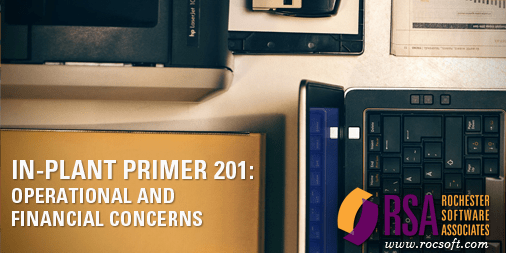- Howie Fenton
- |
- October 30, 2017

This article is part of our dealer and vendor in-plant education initiative called "In-Plant Primer: From Operations Basics to Advanced Sales Concepts. Divided into six basic (101) and six advanced topics, this is the fourth post of the advanced in-plant primer series, "In-Plant Primer 201: Operational and Financial Concerns." In this advanced portion of the primer series, we're covering topics like vertical markets, financial models, terms to use and avoid with in-plants, and more. Access your RSA partner resource portal to download the two series eBooks or listen to the August 23 webinar recording about all the topics.
Key Take Aways
- The benefits and value proposition for in-plant managers and executives are different
- There are internal and external threats that impact the benefits and value proposition
- The in-plant manager must work hard to avoid customer complaints and meet financial objectives to avoid scrutiny.
View of the In-plant's Value and Benefits Depends on Level of the Person and the Effect of Certain Factors
In our last post, we talked about the right and wrong language to use with in-plants. We learned that what is important to the plant manager is not always what is important to their boss (the C-Level executive). While the plant manager is often consumed by day-to-day production concerns (quality, on-time delivery, customer satisfaction), the C-Level executive is typically more focused on the financials. In this blog, we will talk about how the value and benefit of the in-plant is different for the manager and the executive and the effect of internal and external factors. The benefit of the in-plant to the managers is that it provides jobs for them and their staff. In addition, since they had a hand in building it and they have relationships with staff and customers, it provides a sense of pride for them. The value proposition for them is that the in-plant provides a convenient, fast service and that meets their customers' needs. Based on conversations with C-Level executives, the benefit for them is that the in-plant provides a convenient, fast service that meets their customers' needs of quality, on-time delivery, and competitive pricing. The value is that the in-plant meets the financial objective of the business model.
Internal VS External Threats
When there is an internal problem however, the benefits or value of the in-plant can become threatened. When there are complaints from customers (turnaround time, quality or cost), the benefit to the in-plant to the manager remains (jobs, relationships, pride), but the value to the executive (meeting the financial objective) may become threatened. More seasoned executives may allow one or two quarters, but not one or two years. In addition, external factors can come to bear which impact the executive more than the manager. Management trends can sweep across companies for a wide variety of reasons. A few of those reasons are:
- A senior management change can prompt a scrutiny of all departments as they attempt to prove their value
- Poor financial performance of the parent company can motive a "belt tightening"
- Success in outsourcing in another area can motive investigation of the in-plant.
These external factors can result in an "evaluation" of the in-plant which threatens the benefit of the in-plant to the managers (jobs).
Summary
Neither the in-plant manager or the C-Level executive have control over the external factors that can result in scrutiny. In contrast, the in-plant manager can have control over internal threats. Simply put, the in-plant manager must work hard to avoid customer complaints (turnaround time, quality or cost) and meet their financial objective to avoid scrutiny. In our next 201 primer article I'll discuss measuring operational performance, and which measurements are to improve performance, and which are best for reporting purposes.
Never Miss an Article Again. Subscribe and Learn
Don't miss any learning opportunities; subscribe to RSA's email updates and we’ll automatically alert as each article is published.